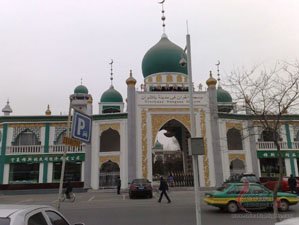
Islam is the newest world religion to come to China. Many Muslims say that Muslim missionaries arrived in China in the year 651. If so, they came soon after the founding of Islam by Mohamed in what is now Saudi Arabia about the year 600 AD. They came soon after his death. This is about 16 years after a Nestorian Christian missionary named Alopun went to Chang An. Islam arrived after Buddhism and Christianity. Muslim traders began to arrive in China during the Tang Empire, and perhaps hundreds of thousands of Muslims were brought to the Mongol Yuan Empire by the Mongols who used them to govern and administrate China, and many of the Mongols themselves became Muslims. The religion spread quickly in Central Asia by Muslim conquest of the nomadic tribes and empires between Arabia and China. In this way, many small ethnic groups that are in western, northern, and southeastern China such as the Uighurs, Kazakhs, and Tajiks became Muslim. In China, people are mainly Muslim by birth since few Chinese convert. It is the third largest world religion in the country after Buddhism andChristianity, with about 20 to 30 million Muslims nowadays. Islam has had a long and interesting history in China, and nowadays ethnic Muslims are growing in interest and knowledge of the religion.
Muslims ethnic groups are mainly along the borders of modern China in Yunnan, Tibet, Xinjiang, Gansu Province and Henan Province. Of the 55 or so minority groups, about ten groups are classified as Muslim though individuals may profess another religion or no religion. Intense anti-religious education and persecution during the Communist era had the effect of decreasing the belief in the religion, so many ethnically Muslim people don’t believe the religion. Uighurs are the biggest ethnic Muslim group with about 10 million people who live mainly in Xinjiang. They became Muslim about 400 or 500 years ago. The second biggest group are the Kazakhs. About 2 million of them live mainly in Xinjiang.
The Hui people are about 12 million Chinese Muslims who live all over China. They can be seen in every Chinese city and almost every town all over the country because they often have Lanzhou Lamian restaurants and often wear white caps or scarves. Lanzhou is the name of a big city in Gansu Province in northern China. Lamian means pulled noodles. They are known for making their own fresh noodles in their restaurants out of wheat flour and not eating pork. It seems that they have spread evenly all over China setting up Muslim restaurants. There is a market for this because Muslims traditionally can’t eat pork and have other diet laws similar to Judaism, so Muslims can’t eat at regular Chinese restaurants. Also, the freshly made noodles actually taste very good. The government lists Hui people as an ethnic group although they are simply Chinese Muslims who are perhaps descended from Mongols or foreign traders and administrators. These restaurants are on almost every street in Chinese cities, and the large number of them makes it seem that Muslims are a large percentage of the population of China, but estimates say that Muslims are about 2 percent of the population. Christians may be about 5 percent of the population.
Because of the intense warfare between Chinese and Muslims in the 19th and 20th centuries and because the government didn’t want people to believe the religion, most Muslims in China are not very religious. People are regarded as Muslim if they are of ethnic Muslim descent or follow Muslim customs. However, now that religion is permitted in China and the ethnic people have more contact with foreign Muslims and mosques are rebuilt, many now have a great interest in the religion and follow the Muslim traditions such as prayer and going to mosques.

No comments:
Post a Comment